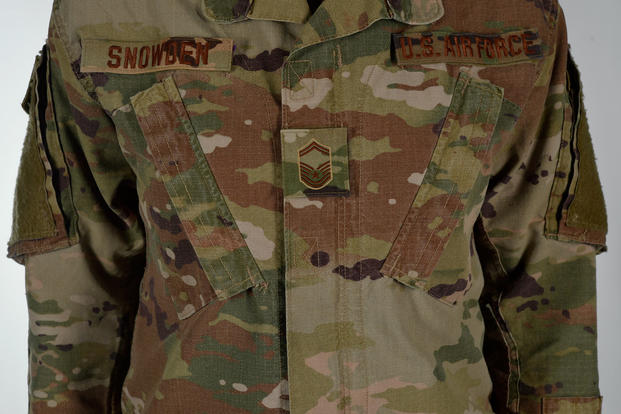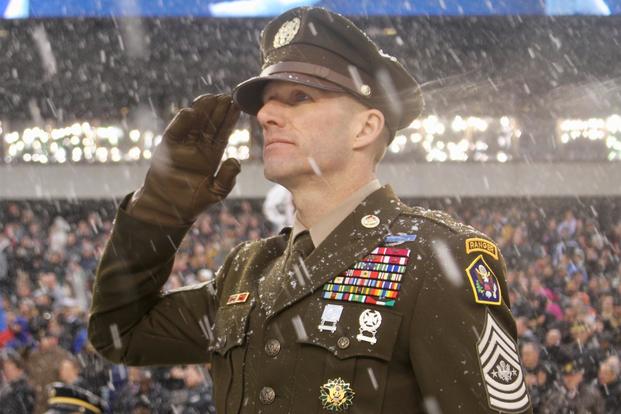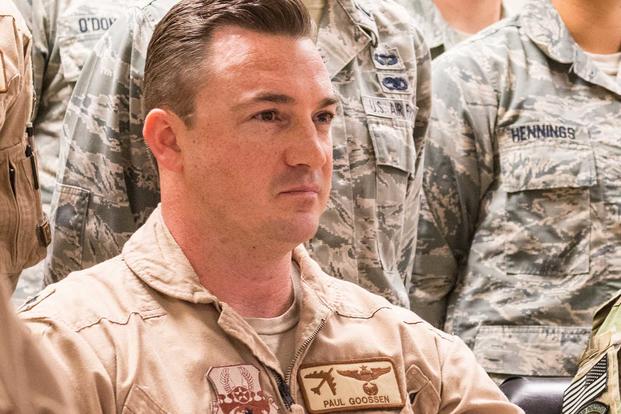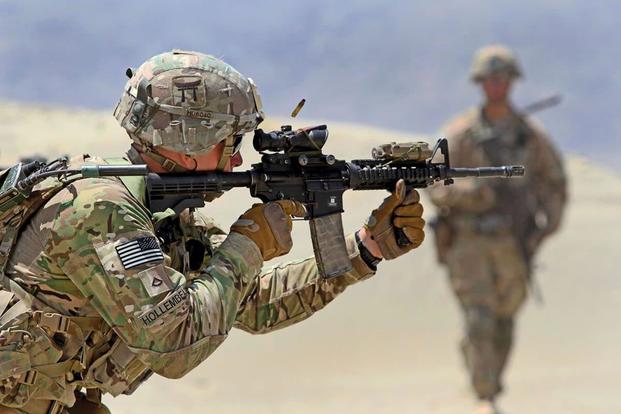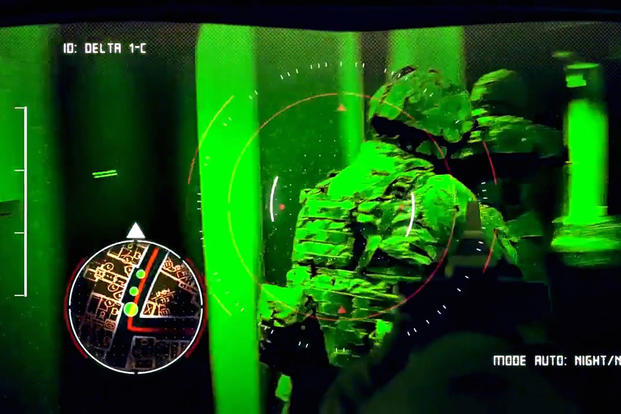The U.S. military saw an eventful year in 2018, from the announcement of a new military branch dedicated to space, to approval of the largest pay raise in years, to the less serious but much discussed "sky penis" scandals.
This list highlights 10 topics from 2018 chosen by Military.com editors as having the most significance.
But we also want to hear from you: What stories that affected the military this year do you think were the most important? Let us know by responding in the comments section or sending us an email.
Troops to Get Largest Pay Raise in Years, Tricare Changes Start
Troops, military families and retirees this year welcomed news of upcoming pay and cost-of-living increases for 2019 – the largest in years -- and waded through a variety of changes to Tricare benefits. In addition to increased out-of-pocket drug costs, Tricare users braved a system overhaul that included region swaps, program name changes, new fee structures and the system's first-ever open season.
Meanwhile, troops who met the date cutoff faced a deadline to choose whether to opt into the Defense Department's new Blended Retirement System. And a change to the rules surrounding post-9/11 GI Bill transfers meant that many senior military members must choose to make the transfer or potentially forgo the option.
Army, Air Force Issue Major Uniform Changes
The U.S. Army and Air Force announced two major uniform changes in 2018. In May, the Air Force announced it would adopt the Army's Operational Camouflage Pattern, or OCP, to replace the pattern on the Airman Battle Uniform, known as the ABU. Four years have passed since the Army adopted OCP, a pattern similar to MultiCam that was developed around 2002 for the Objective Force Warrior program.
The other major uniform change of 2018 came with the Army's Veterans Day adoption of a version of the World War II pinks and greens uniform as the service's new everyday dress uniform. The new Army Greens uniform will become mandatory for wear in 2028, and the current blue Army Service Uniform, or ASU, will become the service's optional dress uniform.
'Sky Penis' Scandals Rock Corps, Air Force
The year saw a spree of aerial maneuvers by various U.S. military units that involved drawing penises across the sky. Two West Coast-based Marines were under investigation for executing a flight pattern that resembled a phallus in late October and were later restricted to ground duties and administrative discipline, the Marine Corps said earlier this month. It was suspected that Air Force crews over Ramstein Air Base, Germany, attempted their own sky penis drawing in April. And the commander of a B-52 Stratofortress squadron at Minot Air Force Base, North Dakota, was relieved of duty in November after sexually explicit and phallic drawings were found during a deployment to Al Udeid Air Base, Qatar. Lt. Col. Paul Goossen of the 69th Bomb Squadron attempted to stop his fellow airmen from drawing "d---s everywhere," according to the investigation, which included penis drawings discovered on a moving map displayed on the B-52's Combat Network Communication Technology (CONECT) cockpit software.
VA Mission Act, Forever GI Bill Continue to Face Hurdles
The Department of Veterans Affairs began the year in turmoil over who was running the place, all the while officially denying there was any "turmoil." Via Twitter, President Donald Trump fired VA Secretary Dr. David Shulkin in March and then saw his first replacement choice, White House physician Rear Adm. Ronny Jackson, withdraw over never-proven allegations of misconduct.
Robert Wilkie, who had been the personnel chief at the Pentagon, was finally confirmed as VA secretary in June. He later acknowledged that, yes, there had been "turmoil" at the VA but said it was all in the past. The department was now focused on a series of enormous tasks to speed appeals, mesh medical records with those of the Pentagon, get things straightened out on the GI Bill and -- biggest of all -- use 2019 to implement the VA Mission Act to improve veterans' access to VA-approved community providers of health care.
The bill also promised the expansion of caregiver benefits to veterans of all eras, not just the post-9/11 generation. House Veterans Affairs Committee Chairman Phil Roe, R-Tennessee, an obstetrician, warned repeatedly that meshing the records of private physicians with those of the VA would be a daunting challenge for the department's antiquated IT systems. The initial signs for a smooth transition to the Mission Act are not promising. The VA botched the rollout of changes to housing allowances under the GI Bill because the IT system couldn't handle it. A fix is supposed to be in place by December 2019. A pilot program in Washington state on meshing VA and Defense Department medical records has also run into problems; they found out they need new computers.
A Sixth Military Branch: Space Force
The Pentagon has long eyed better protections for its space satellites, weapons and communications. Lawmakers last year even toyed with the idea of creating a "Space Corps" within the U.S. Air Force. But President Trump took it a step further when he announced his intention to create a sixth branch of the military, a Space Force.
The proposal has been controversial, and some details are missing. From increased costs to organizational challenges, the possibility of "Space Marines," and arguments over who would be in charge, the planned quick pace for the new Space Force has yet to hit the Pentagon's fiscal 2020 budget books. But a third and final report from the deputy defense secretary's office is due soon on how best to advise lawmakers on the appropriate legislative language needed for the budget request. Whether the Democratic-led House will go for it is another question.
Army Announces New Fitness Test, Standard
Last summer, the Army launched a major effort to increase the fitness of its soldiers. By October 2020, the new Army Combat Fitness Test will become the test of record for all soldiers. The six-event ACFT will replace the current three-event Army Physical Fitness Test.
In October, the service began a large-scale field test of the ACFT involving 60 battalions across the active forces, National Guard and Reserves. News of the ACFT, which is intended to be a fitness evaluation designed to prepare soldiers for the rigors of combat, ignited excitement but also served as a wakeup call for some soldiers who now have about 18 months to prepare to meet the Army’s new fitness standard.
Army Finds M4 Glitch, Moves Toward More Powerful Rounds
It took six months, but Army weapons officials found the cause of a mysterious and dangerous glitch in the selector switch of M4 and M4A1 carbines that can cause the weapons to fire unintentionally.
In March, the Army's Tank-automotive and Armaments Command sent out a safety-of-use message advising units to perform an updated functions check on all variants of the M16 and M4s after a soldier experienced an unexplained, unintended discharge when his M4A1 selector switch became stuck between the semi- and automatic settings. Weapons officials scrambled to investigate the problem after roughly 3,000 Army M4 and M4A1s failed new safety inspections.
The glitch turned out to be a tolerance issue with the internal firing components.
Also this year, the Army moved forward with its Next Generation Squad Weapon program, an effort to replace the M249 squad automatic weapon and the M4A1 carbine with weapons that feature a more powerful round than the current 5.56mm. The service's interest in an advanced 6.8mm round for the program emerged from a 2017 Small Arms Ammunition Configuration Study.
Hurricanes Wallop Bases, Force Relocations
Hurricanes, tropical storms, wildfires and earthquakes all affected the U.S. military this year. Troops deployed to support local relief for disasters in California, North Carolina and Florida, among other states. Bases were hammered by barreling storms for days on end. The military has been more involved in recent years as uncertain climates pose what the Pentagon has called a "looming threat" to defense operations. Hurricane Michael devastated Tyndall Air Force Base, Florida, with more than 95 percent of the base left uninhabitable. A number of F-22 Raptors were damaged during the storm.
The Air Force is considering consolidating the stealth fighters in Hawaii, Alaska and Virginia, and perhaps moving other air operations to Tyndall when it's back in action. Elsewhere, the California wildfires were fought with the help of the Air and Army National Guard, and an earthquake struck Alaska, disrupting day-to-day life for Joint Base Elmendorf-Richardson. Tropical storm and typhoons also created problems on Guam's Air Force flightlines.
Close Combat Lethality and Subterranean Warfare
Defense Secretary Jim Mattis kicked off 2018 by standing up a Close Combat Lethality Task Force. The $2.5 billion effort -- which mainly focuses on the Army and Marine Corps -- is designed to ensure that infantry squads and other small combat units receive the most updated training, weapons and equipment for engaging enemy forces in close combat.
Also in 2018, Army officials confirmed that the service is spending nearly $600 million to provide special training and equipment to prepare the majority of its active combat brigades to be able to fight in large-scale, subterranean facilities beneath major cities.
North Korea Confrontation Looms Again
North Korea rattled the U.S. and the world in 2017 with ICBM and nuclear tests that at one point had residents of Hawaii dusting off the duck-and-cover drills when a false alarm of an incoming attack sounded. There appeared to be an improvement in relations in the astonishing Singapore summit in June between President Trump and North Korean leader Kim Jong-un, the first-ever meeting of a U.S. president and the leader of the Stalinist regime. Trump said Kim had agreed to the "complete, verifiable and irreversible" dismantling of his nuclear and missile arsenal. He ordered the U.S. military to cease "provocative" exercises with South Korea. North Korea returned the remains of what were believed to be 55 U.S. troops missing from the Korean War and vaguely agreed to cooperate on returning more. There improvements stopped.
The North has yet to move on disarmament while pursuing more dialogue with South Korean President Moon Jae-in. Sometimes, the North Koreans will agree to meet with U.S. Secretary of State Mike Pompeo; sometimes, they won't. In many ways, the relationship has reverted to the old tit-for-tat format of sanction and threat. In December, the U.S. slapped sanctions on three close associates of Kim and slammed North Korea for human rights abuses of its people. North Korea's propaganda mills responded with old-timey screeds about "hostile acts" and the "intolerable political provocations" fomented by the imperialist warmongers.
Bonus: Mattis Resigns as SecDef amid Trump-Ordered Troop Pullouts
Defense Secretary Jim Mattis resigned Dec. 20, seemingly in protest of President Donald Trump's orders to withdraw from Syria and an "America First" policy that appears to discount the value of allies and local partnered forces fighting alongside U.S. troops. The announcement followed on the president's surprise move to withdraw U.S. troops from Syria, a move widely seen as a rejection of Mattis' commitment to stand by partnered forces in Syria until a lasting defeat is dealt to the Islamic State. Later reports said Trump had also ordered a drawdown of troops in Afghanistan.
-- Richard Sisk, Matthew Cox and Oriana Pawlyk contributed to this report.
Stay on Top of Your Military Benefits
Military benefits are always changing. Keep up with everything from pay to health care by signing up for a free Military.com membership, which will send all the latest benefits straight to your inbox while giving you access to up-to-date pay charts and more.

